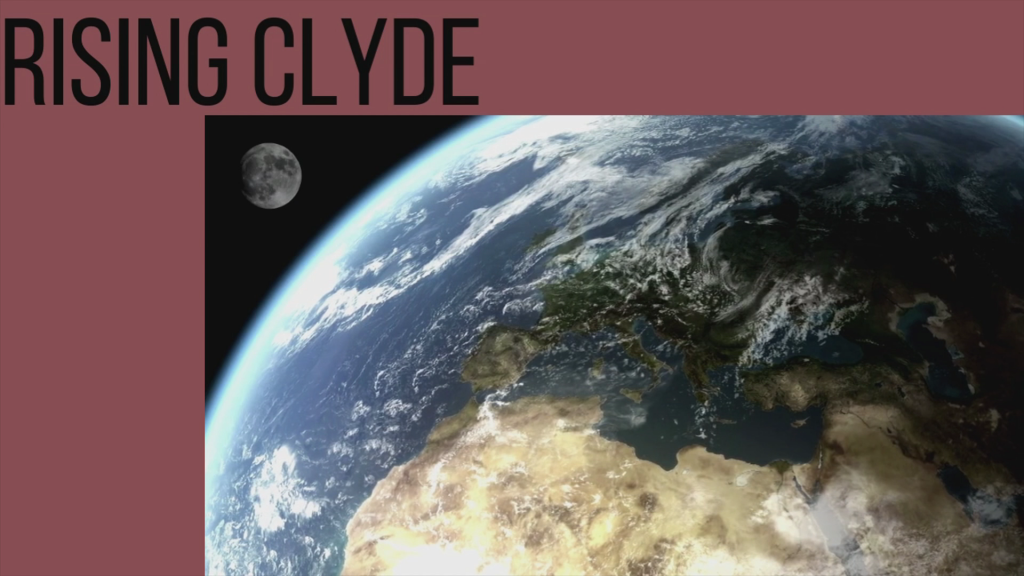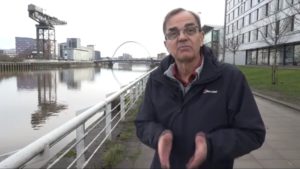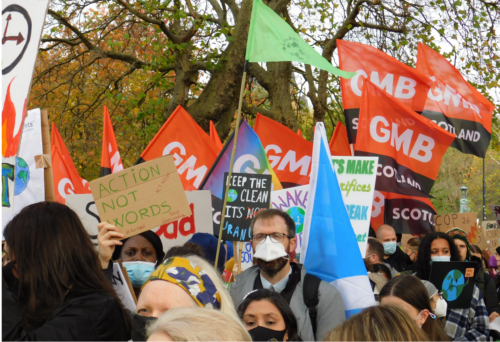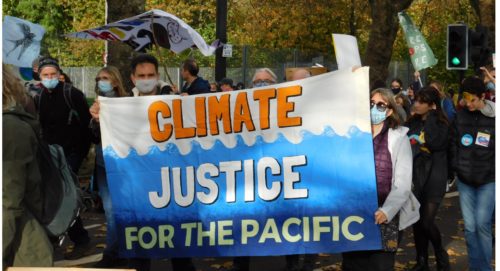COP28 (along with planet Earth) is faced with “an absolutely gobsmackingly bananas increase in the global temperature”
COP28 – the annual UN global summit on global warming – is taking place from November 30th until December 12 – under the auspices of UN Framework Convention on Climate Change that was launched in 1992 to protect the planet against “dangerous anthropogenic interference with the climate system”, which now takes place annually. It is the 28th UN climate change summit since 1992, and will take place in Dubai in the United Arab Emirates (UAE).
COP28, along with other recent such summits faces a deadly, and indeed existential, contradiction between the relentless acceleration of global warming i.e. of the average global surface temperature of the planet – and the inability of the COP process to bring it under control, or even hold it to a maximum increase of 1.5°C in line with the 2015 Paris Agreement.
It became clear in August that 2023 would be of a different order of magnitude in terms of temperature when July turned out to be the world’s hottest month ever recorded.
The UN Secretary General António Guterres – the most radicle the UN has had on climate change – responded rightly by declaring that this meant that “the era of global warming had ended, and the era of global boiling has arrived”. It meant, he said, that: “Climate change is here, it is terrifying, and it is just the beginning. It is still possible to limit global temperature rise to 1.5°C (above pre-industrial levels), and avoid the very worst of climate change, he said, but only with dramatic, immediate climate action.”
The September figure, however, was a whole lot worse. It was a staggering 0.5°C above the previous such record. The Guardian’s environmental editor Damian Carrington quoted climate scientist Zeke Hausfather who had tweeted that: “This month was, in my professional opinion as a climate scientist – absolutely gobsmackingly bananas. It beat the prior monthly temperature record by over 0.5°C, and was around 1.8°C warmer than preindustrial levels.” He noted that datasets from European and Japanese scientists confirmed the leap.
It’s worth noting that the difference in the average global temperature between now and the depths of the last ice age when these islands were under a kilometre of ice is around 5.0°C.
In mid-November Guterres went further warning that. “Present trends are racing our planet down a dead-end 3C temperature rise. This is a failure of leadership, a betrayal of the vulnerable, and a massive missed opportunity. Renewables have never been cheaper or more accessible. We know it is still possible to make the 1.5 degree limit a reality. It requires tearing out the poisoned root of the climate crisis: fossil fuels.”
He added: “Leaders must drastically up their game, now, with record ambition, record action, and record emissions reductions. No more greenwashing. No more foot-dragging.”
The UK’s sellout
One member state that has not upped their game – scandalously – is the UK under Sunak’s Tory government – which has gone in exactly the opposite direction. In order to exploit a reactionary backlash from car drivers against Labour in a recent byelection Sunak has delayed the ban on the sale of new petrol and diesel cars from 2030 to 2035 will deprioritise the transition to electric vehicles. He has also announced that a ban on the sale of fossil-fuel boilers from 2035 would be watered down and extra exemptions introduced.
Most significantly he has issued a new generation of oil and gas licences for the North Sea and given the go-ahead for a new oil and gas field. It is a monumental stab in the back for the whole COP decarbonisation process.
Sunak insists (ludicrously) that none of this will affect the ability of Britain can still reach his 2050 net zero target. The UN has strongly protested.
The venue
The venue of this COP is a major problem of course. Few countries could be less suitable for such a summit than the UEA. It is not only the 7th biggest oil producer in the world at 3,250,000 barrels a day. It also holds the 7th largest proven reserves of natural gas in the world at over 215 trillion cubic feet. It is also yet another host nation, following Sharm El-Sheikh, with an appalling history of human rights abuses and an economy based on fossil fuel exports, and the president of the COP will be Sultan Ahmed Al Jaber who is the Minister of Industry and Advanced Technology of the UAE, and managing director and group CEO of the Abu Dhabi National Oil Company.
As a result of this, many campaigners will not travel to Dubai in person but will mount their protests at home or via the global day of action which has already been called for the last day of the summit which is Decembe12th. The problem has been compounded, however, by the astonishing revelation that the UEA has been using COP meetings to sell off oil and gas on the side. Guterres has denounced it as a serious breach of the standards of conduct expected of a COP president.
It would be a mistake, however, to allow the venue problem to dominate our response. It is difficult for the UN to exclude a member state from the presidency when they are seeking to take their 193member states together towards net zero and when hosting a COP often has a positive effect of the host nation in terms of its own record.
The primary role of a COP summit in any case in pushing the member states to meet their commitment takes place between COP meeting rather than at them when the die has often been cast, also to plan actions and interventions for the following year. In the end the COP process has to be bigger than this since it is dealing with a global existential emergence with a short time line for it conclusion.
The COP conferences, however, urgently need democratising in order to give the climate movement a lot more space and to severely restrict corporate lobbying the access to it given to the petrochemical industry.
The aim of the climate movement should be to maximise mobilisations around every COP summit and where it is not possible at the venue it should be done at the international level. This is important both in order to mobilise the movement and also because it is the best opportunity we have to put demands on the global elites at an international level.
Meanwhile Al Jaber, COP president on behalf of the UAE, has told the Guardian in an exclusive interview on the eve of the conference that he thought that the world could agree a “robust roadmap” of cuts in greenhouse gas emissions by 2030 that would meet scientific advice.
We shall see.
Key challenges in Dubai
The principal responsibility of each COP is to conduct a global stocktake of the carbon reduction targets—or “Nationally Determined Contributions”— to which each member state is pledged as a part of the so-called “ratcheting up process” adopted at COP21 in Paris in 2015. This requires each member state to set its own carbon reduction targets and then review and enhance them annually at implementation conferences such as COP27 and now COP28.
In this case every member state must meet the commitments it made at COP27 in in Sharm El-Sheikh and adopt new ones set at a stricter standard – which must be backed by a credible plan for implementation. The stocktake that took place last year at COP27 in Sharm El-Sheikh revealed a disastrous situation, and this could be even worse.
The loss and damage fund
The other massive issue that will rear it head again – and rightly so – is the matter of a so-called “loss and damage fund”.
This fund was agreed in principal in Sharm El-Sheikh after a long and heated debate. It would provide a mechanism by which the rich countries, that are most responsible for climate change, would be required to pay into a fund that could mitigate the impact of climate change on the poor countries, who are the least responsible for climate change, and help them with a just transition to renewable energy. There was no agreement, however, as to how much money should be paid into it, who should pay it, or on what basis. The UNs International Panel on Climate Change (the IPCC) was , therefore, asked to prepare a recommendation, particularly on the size of the fund for the COP28 in Dubai.
The creation of such a fund had been blocked by the rich countries for over 30 years and was only forced onto the agenda this year after heavy pressure from the poor (or developing) countries themselves. Prior to COP27 Guterres had argued strongly for such an agreement, warning that unless there is what he called an “historic pact” between the rich and poor countries on this issue, the planet could already be doomed. In other words without a serious loss and damage fund to provide a socially and economic transition the UN will eventually, and inevitably, fail.
This issue has been given a substantial boost on the eve of the summit when 70 international figures led by Gordon Brown, and including former UN Secretary General Ban Ki-moon, have sent a letter to the COP calling for the massive revenues of oil-producing states to be subject to a $25bn levy to help pay for the impact of climate disasters on the world’s poorest and most vulnerable people.
Brown told the Guardian: “The deadlock on climate finance has to be broken if Cop28 is to succeed. After more than a decade of broken promises, a $25bn oil and gas levy paid by the petrol states and proposed by the UAE as chair of Cop would kickstart finance for mitigation [reduction of greenhouse gas emissions] and adaptation in the global south”.
Such a levy, he said, would shave off only a small fraction of the bonanza that oil-producing countries have made in recent years, but it would help to fill the “loss and damage” to poor countries afflicted by the impacts of the climate crisis.
The role of the UN
The state of the climate struggle today can be seen from the following harsh realities:
- the science remains irrefutable (though often understated by the scientific community)
- the time available to reach net zero is rapidly running out
- the limitations of the COP process become ever more apparent
- Anthropogenic global warming is accelerating at an unprecedented rate and dangerous tipping points are fast approaching – some have already arrived.
- The COP process has to be made to work because there is no alternative.
It is a pivotal moment for the UN since faced with such contradictions its entire carbon reduction project is falling apart leaving the global climate to spin out of control and cause more tipping points to trigger – which would be catastrophic for both the UN and the planet.
Many on the radical left argue that this failure was and is inevitable because the UN it is a capitalist institution, and as such is dedicated to the preservation of the fossil industry and prepared to use as much “greenwash” as necessary in order to do so and it is time for the left (however defined) to go it alone. There have been numerous proposals in recent years for the left to denounce the COP process as a road block and withdraw from it.
This would be a big mistake. The UN is, of course, a capitalist institution. It is comprised of 193 capitalist countries: how could it be otherwise. To its great credit, however, it recognised the danger of anthropogenic climate change as early as 1992 when the radical left still regarded the environment as a middle class diversion. Since then the COP process it established has been a battleground between the majority who recognise the problem and are prepared to decarbonise at least to some extent, and those who simply defend their own self-interest or who reject the concept of anthropogenic global warming on ideological grounds – i.e. the climate change deniers.
In the event the UN – along with its subdivisions such as the IPCC – were not only successful in defeating the climate deniers – despite the massive backing they received from the fossil fuel producers – but in winning the scientific community over to the climate struggle, without which we would be nowhere today. It has also been instrumental, along with the intensification of the climate crisis its self – in transforming global awareness as to the dangers of climate change.
Today was are facing an existential climate emergency, which only the UN, or something with a comparable global reach and authority can successfully confront.
This is important since although the struggle against climate change must include individual responsibility, in the end it is only governmental action—and ultimately governments that are prepared to go on a war footing to do so—that can make the structural changes necessary to stop global warming in the few years that science is giving us to do it.
The role of the radical left
To the extent that the radical left in particular had or has a strategic approach by which to global warming and climate change it is the revolutionary overthrow of capitalism, though how clearly this has been thought through is not always clear. To be relevant to global warming, however, it would have to happen within this decade since nothing can be built on a dead planet.
The actual task we are faced with today, therefore, is not whether global capitalism can be abolished within 10 years, but whether it can be forced to take action to halt global warming
as a part of a struggle for its eventual overturn and its replacement by an ecosocialism. If we are unable to build the kind of movement capable of forcing major change under capitalism, how are we going to build a movement capable of overturning it. It is what I would call a transitional approach.
It is not true – as some on the left imply – that capitalism cannot be forced to make major changes that are contrary to the logic of its existence. In fact it was already making concessions to this when it agreed under extreme pressure to support a maximum global temperature increase of 1.5°C in Paris and when it agreed to end the use of fossil fuels in Glasgow.
Capitalism would also be prepared, in my view – given the existential implications – involved to carry though decarbonisation its self rather than see societal collapse, since to do so would meet with massive resistance. It would do so completely in its self-interest and with extreme brutality. We cannot assume, in any case, that global warming will be halted incrementally – or indeed peacefully – before runaway climate chaos along with societal and ecological break downs and if so ultra-right and fascist forces will be waiting in the wings.
Mass movements will emerge spontaneously under such conditions, problem however, will be which class interests do they represent. Whether they are led by progressive forces (including the left) ultra-right populists with a reactionary agenda, that are already flexing their muscles around environmental issues.
A major task of the radical left today – as well as being involved in every aspect of the struggle –implies conscious preparation for such an eventuality, which could already happen at any time.
Meanwhile, the most effective way to cut carbon emissions quickly and democratically is by making fossil fuels much more expensive than renewable energy, by means that are socially just, economically redistributive, and capable of commanding popular support – and in the two or three decades that remain to us.
The UN COP process remains a crucial forum in the struggle for such demands remains. It is the best forum through which the global climate movement can place demands on the global elites and the forum around which we can build the kind of mass movement that can force them to take effective action.
Key carbon reduction issues
- The global average surface temperature to below a 5°C increase
- Demand net zero by 2030
- All new fossil fuel investment must be stopped
- The polluters must be made to pay
- Global biodiversity must be defended
- There must be a rapid transition to renewables: including solar, on-shore and off-shore wind, tidal and hydro carried out on a ‘war footing’. (In UK Labour must maintain its commitment to £28 billion a year on renewables)
- The 2030 deadline for selling fossil fuel cars must be maintained
- SUVs must be banned other than in specialised circumstances
- Adequate production facilities for EV batteries must be established
- There must be a major extension of public transport and fewer cars
- The national grid must be upgraded
There must be a massive programme of home (and building) insolation. All new homes must meet strict environmental standards
- LTNs and 15 minute cities must be introduced to cut carbon emission and clean up the air we breathe
- Decarbonise agriculture, ban deforestation, a big reduction in meat production and consumption. End the ploughing of fields.
- Stop the pollution of land and sea and rivers
- Protect wetlands
- Far better recycling and the detoxification of waste disposal
- No to nuclear energy
29 November 2023
Republished from Red-Green Labour: https://redgreenlabour.org/2023/11/29/cop-28-what-is-at-stake/






